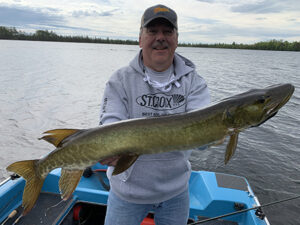By Steve Heiting
Year in and year out, minnowbaits account for a large percentage of the muskies in my boat, including some of the largest. Their strike-triggering characteristics make them effective from the musky opener all the way until ice-up.
Minnowbaits produce fish whether the muskies are on the prowl or are turned off, and can be fished over weeds, around rocks or for fish suspended in deep water away from structure.

A minnowbait is nothing more than a flat-sided crankbait. Thanks to their diving lip, their wiggle will make muskies to bite if you simply cast one out and reel it back to the boat. This makes them popular for trolling. But for the casting musky angler, a minnowbait’s flat sides is what make the lure type so productive. Broad sides flash and reflect light, making the bait obvious to a sight-feeding predator.
Everyone has twitched a Rapala or similar lure for bass, and minnowbaits are most effective for muskies when twitched, too. The technique follows the same principle of a darting, flashing bait fished with a stop-and-go retrieve, only with bigger baits. In early season and following the passage of a cold front, 5- to 7-inch minnowbaits are the best choice. Once summer has arrived and through the remainder of the year, 8- to 10-inch minnowbaits are the pick. Some of my favorite baits — which are available in small and large sizes — include Slammers, ShallowRaiders, Grandmas, Jakes, and Skinners.
Color choice depends on the lake you plan to fish. Note the diving lip on the front. A rounded lip will cause your bait to roll and produce more of a subtle flash. Square lips create a more violent twitch and more flash. Stock up with both types as muskies may prefer one over the other.
Since minnowbaits have flat sides, there isn’t much trapped air inside them to provide buoyancy, and some like the Slammer and Skinner models are constructed of solid plastic. Therefore, it’s important to use a lightweight leader with smaller baits so they aren’t overwhelmed. A heavy leader will minimize the bait’s action and cause the bait to hang or rise nose-down between twitches. A couple years ago I worked with Stealth Tackle to develop its line of twitchbait leaders, which are available with or without swivels. You don’t need a swivel with twitchbaits, and going without one further reduces weight in front of the bait.
You’ll get better action from your bait if you match rod power to your minnowbait’s size. For 5- to 7-inch minnowbaits, I prefer a medium-heavy action and almost always will be using an 8-foot-6 St. Croix Legend Elite LEM86MHF or Legend Tournament LM86MHF.
Retrieve speed doesn’t matter, so choose any quality baitcasting reel and spool it with 65-pound test braided line. Larger minnowbaits require heavier gear. I use either an 8-foot-6 St. Croix Legend Elite LEM86MF or a Legend Tournament LM86MF. Any quality baitcasting reel spooled with 80- or 100-pound test braided line, and a Stealth 130-pound test fluorocarbon leader, is the perfect set-up.
In bass fishing, it’s effective to let the surface settle after when twitching, but it’s not necessary with muskies. After my musky minnowbait splashes down, I begin the retrieve immediately unless weed growth reaches to the surface. In that case, I’ll let the bait float to the surface before I begin the retrieve to keep it a couple inches higher in the water column. I typically twitch a bait with an upward motion of my rod tip until the bait is about halfway back to the boat, when I’ll switch to a downward motion to keep from pulling the lure from the water.
Cadence is up to you. You are the magician. Give the minnowbait a couple twitches and then pause to let it rise in the water column. Twitch it again and let it rise. Mix up the number of twitches before pausing all the way back to the boat. Remember to let your bait rise with slack line, but pick up the slack line as you retrieve to maintain contact. This is called “controlled slack.” Rather than pulling sharply and downward with the rod, learn to twitch with your wrist with the rod pointed to the side to get better action.
A musky’s strike will almost always occur during the pause when there is some amount of slack line. You may only see a boil, feel a tick, or a solid thunk, but set the hook hard. You’ll catch more muskies if you keep your hooks razor-sharp with a flat-edged file.
Casting a minnowbait over emerging weedbeds or incoming streams near spawning areas is a sure bet for early musky action.
